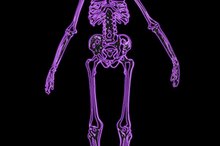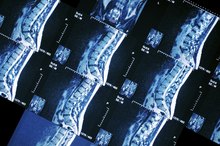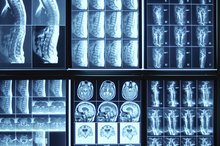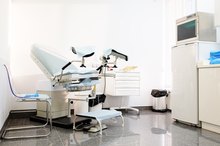What does fact checked mean?
At Healthfully, we strive to deliver objective content that is accurate and up-to-date. Our team periodically reviews articles in order to ensure content quality. The sources cited below consist of evidence from peer-reviewed journals, prominent medical organizations, academic associations, and government data.
The information contained on this site is for informational purposes only, and should not be used as a substitute for the advice of a professional health care provider. Please check with the appropriate physician regarding health questions and concerns. Although we strive to deliver accurate and up-to-date information, no guarantee to that effect is made.
Abnormal Bone Scan Results
A bone scan is a nuclear imaging test physicians use to look for areas of increased or decreased bone metabolism. Physicians often use this study in conjunction with other tests to diagnose bone infections, cancer or other degenerative bone diseases.
If you are experiencing serious medical symptoms, seek emergency treatment immediately.
Testing
During a bone scan, a technician injects a radioactive material into a vein. The substance travels throughout the bloodstream, organs and bones. After the substance wears off, it gives off radiation the imaging equipment can pick up. The National Institutes of Health explains that bone scans performed to look for an infection in the bone involve a three-phase scan 2. Technicians take pictures just after the technician injects the radioactive material and again three to four hours later, after the material has collected in the bones. If a physician is using the bone scan to detect cancer in the bones, the technician takes images only three to four hours after the injection of the radioactive material.
- During a bone scan, a technician injects a radioactive material into a vein.
- If a physician is using the bone scan to detect cancer in the bones, the technician takes images only three to four hours after the injection of the radioactive material.
Abnormal Results
What Do White Spots on a Bone Scan Indicate?
Learn More
Abnormal results do not necessarily mean that a person has a bone disease. Abnormal results mean that the radioactive material did not distribute evenly throughout the bone. The radiologist looks for darker spots called hot spots as well as lighter spots called cold spots to look for places where the radioactive material may have accumulated. While a bone scan is sensitive to bone abnormalities, it is less helpful in determining the cause of the abnormality, according to MayoClinic.com 1.
- Abnormal results do not necessarily mean that a person has a bone disease.
- Abnormal results mean that the radioactive material did not distribute evenly throughout the bone.
Follow-Up
When a radiologist notices hot spots on the images, he often recommends further testing to help determine the cause. A physician may order blood tests other more detailed imaging studies such as computerized tomography or magnetic resonance imaging, or a sample of bone tissue called a biopsy in order to help narrow down the actual cause of the hot spots on the images.
Causes
Side Effects of a Bone Scan
Learn More
A bone scan can often help physicians diagnose bone infections, or osteomyelitis, bone tumors and fractures. Bone scans are also helpful in looking for determining whether cancer has metastasized or spread to the bones. Results can show abnormal bone cells and advanced arthritis as well as help determine the cause of bone pain.
Risks
Because technicians must inject radioactive material into the vein, physicians do not recommend the test for women who are pregnant or nursing. If a woman must have the test while breastfeeding, the National Institutes of Health explains that she should pump the breast milk but throw it away for at least two days 2. Risk of reaction to the radioactive material is rare but may cause rash, swelling and a severe anaphylactic reaction.
Related Articles
References
- MayoClinic.com: Bone Scan
- National Institutes of Health: Bone Scan
- Van den wyngaert T, Strobel K, Kampen WU, et al. The EANM practice guidelines for bone scintigraphy. Eur J Nucl Med Mol Imaging. 2016;43(9):1723-38. doi:10.1007/s00259-016-3415-4.
- Hahn S, Heusner T, Kümmel S, et al. Comparison of FDG-PET/CT and bone scintigraphy for detection of bone metastases in breast cancer. Acta Radiol. 2011;52(9):1009-14. doi:10.1258/ar.2011.100507.
- Ohta M, Tokuda Y, Suzuki Y, et al. Whole body PET for the evaluation of bony metastases in patients with breast cancer: comparison with 99Tcm-MDP bone scintigraphy. Nucl Med Commun. 2001;22(8):875-9. doi:10.1097/00006231-200108000-00005.
- Cunha JP. Myoview side effects. Updated August 29, 2019.
- National Library of Medicine. Technetium Tc 99m Bicisate. 2006.
- RadiologiyInfo.org. Bone scan (skeletal scintigraphy). Updated March 1, 2018.
- Brenner, A.; Koshy, J.; Morey, J. et al. The Bone Scan. Sem Nuclear Med. 2012;42(1):11-26. DOI: 10.1053/j.semnuclmed.2011.07.005.
- Tateishi, U.; Gamez, C.; Dawood, S. et al. Bone metastases in patients with metastatic breast cancer: morphologic and metabolic monitoring of response to systemic therapy with integrated PET/CT. Radiology. 2008;247:189-96. DOI: 10.1148/radiol.2471070567.
- U.S. Food and Drug Administration. Highlights of Prescribing Information: Technetium Tc 99m Sulfur Colloid Injection. Silver Spring, Maryland; updated July 2011.
- Wyngaeart, T.; Strobel, K.; Kampen, W. et al. The EANM practice guidelines for bone scintigraphy. Eur J Nucl Med Mol Imaging. 2016;43:1723-38. DOI: 10.1007/s00259-016-3415-4.
Writer Bio
Based in Florida, Martina McAtee has been writing health and fitness articles since 2003. She attended Keiser University, graduating with an Associate of Science in nursing. McAtee is currently working toward a master's degree in nursing from Florida Atlantic University.









